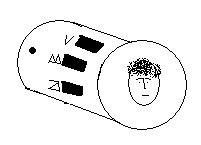I was inspired by
Angelo's post on Oscan abecedaria to dust off the old keyboard; for the future remain many exciting episodes from Italy and some brief things about the APA/AIA convention. The inscription that concerns me here is the following (format snagged from
Sauvage Noble):
"
Rix Fr 13Bronze cylinder, Casalbordino:
a b g d v z ḥ [i] k
Aside from 〈a〉, all the letters are/can be consonantal, without regard for voicing."
It's a bronze cylinder, found at Casalbordino in Abruzzo, now in the Museo Nazionale in Chieti.

This is basically what it looks like, although the cylinder is not as long relative to its diameter as I've sketched it. There's much more pronounced lip where at the end with the face. I'm sorry I don't have a photograph to share at the moment, and we're still waiting on the
Imagines Italicae project. They do have a somewhat useful entry on the
object. It is described as part of a ritual mechanism for distributing
sortes, that is, lots for fortune-telling. However, it may instead have been a part of a
ballista, a kind of torsion-powered catapult (
a diagram). The cylinder would fit on the end of the axle of the winding mechanism, the holes allowing the insertion of levers for winding back the string.
The letters that accompany what were originally ten holes evenly-spaced around the cylinder therefore indicate intervals of 36 degrees up to 324 (360 and 0 being of course the same). This division would give the artillerist a chance to adjust the tension with some degree of regularity, based on prior experience (probably the previous shot!). The cylinder probably dates to the period of the Social Wars, ca. 90 BCE, when many of the Italic tribes took arms against Roman hegemony.







